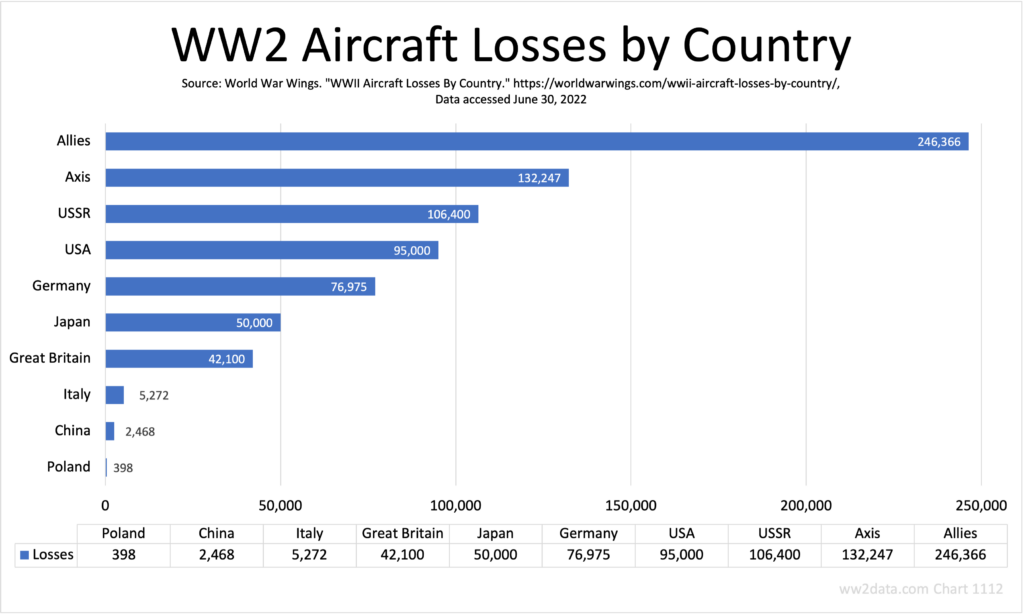The Allies loss aircraft at a 1.9:1 ratio compared to their Axis counterparts. This was part of the price the Allied air forces paid in order to gain air superiority. However, the air superiority that they did gain was a key to final victory.

Table of Contents
Total Losses
The total number of airplanes lost during World War II is difficult to determine with complete accuracy due to varying definitions of what constitutes a “loss” and incomplete or inconsistent record-keeping in some cases. However, estimates suggest that the total number of airplanes lost during the war was nearly 400,000.
The majority of these losses occurred on the Eastern Front, where the Soviet Union and Germany engaged in some of the largest and most intense aerial battles of the war. The Soviet Union alone lost an estimated 106,400 aircraft during the war, while Germany lost around 77,000.
Other countries, such as the United States, United Kingdom, and Japan, also suffered significant losses of aircraft during the war. The United States lost around 95,000 aircraft, the United Kingdom lost around 42,100 aircraft, and Japan lost around 50,000 aircraft.
The loss of aircraft during the war was a significant drain on resources for all countries involved, as each lost not only the cost of the aircraft itself, but also the resources and manpower required to produce and maintain them. Additionally, the loss of experienced pilots and crew members was a significant blow to the effectiveness of air forces, particularly as the war progressed and the need for trained personnel increased.
Noncombat Losses
Estimates suggest that a significant number of aircraft lost during World War II were due to non-combat reasons. Factors such as accidents, mechanical failures, and weather conditions all contributed to the loss of aircraft during the war.
It is difficult to determine the exact number of planes lost due to non-combat reasons, as record-keeping was not always consistent or complete. However, some estimates suggest that up to 30% of aircraft losses may have been due to non-combat reasons.
United States
From December 1941 through August 1945 the United States lost over 42,000 planes due to noncombat reasons, with accidents being a significant contributor to these losses. Specifically, a total of 13,873 planes were lost due to accidents that occurred within the continental US. This was a result of over 52,000 accidents that took place within the country, with 6,039 of these incidents resulting in 14,903 fatalities. (1)
- “United States Air Force Statistical Digest World War II”, Office of Statistical Control, December 1945, Page 309, https://apps.dtic.mil/dtic/tr/fulltext/u2/a542518.pdf
The aviation world was transitioning from cloth covered biplanes to aluminum cladded jet aircraft during the war years. However, aviation was still in its early stages. In 1941, the accident rate for military aviation was 92 accidents per 100,000 flying hours. By 1945, this rate had been reduced to 43 accidents per 100,000 hours, a significant improvement of nearly one half.
Maybe the strangest noncombat aircraft losses occurred on March 23, 1944, Mount Vesuvius erupted, causing immediate devastation to a B-25 bomber outfit stationed at Pompeii Airfield at the base of the volcano. Although the men of the 340th Bombardment Group were able to evacuate and avoid casualties, their fleet of 88 bombers was entirely destroyed.
Axis Downward Spiral
Both Germany and Japan produced more aircraft in 1944 than in any other year. In fact, Germany production rose from 25,527 units in 1943 to 39,807 units in 1944 a year over year rise of 55.9%. Japan’s numbers were equally impressive their production rose from 16,693 units in 1943 to 28,180 units in 1944 a year over year rise of 68.8%. And yet they both in a death spiral in their ability to wage an air war.

There were several reasons for this death spiral but one of the biggest was that both German and Japanese pilots were receiving less and less training in operational type aircraft. See figure 9 above from the “The United States Strategic Bombing Survey The Defeat of the German Air Force” showing how Germany’s pilot training compared to both the Royal Air Force and United States Army Air Force training hours by year during the war. An estimate of 25% of German planes from late 1943 to the end of the war were being lost in noncombat or nonoperational activities.
WW2 Aircraft Losses by Country Data
The above graph can be downloaded as an image.
To download the data shown below from which the graph was developed click on the icon below corresponding to you desired format. Note: to ensure all data is downloaded choose the ‘All’ selection in the Show Entries dropdown list. Otherwise only the data visible on the screen will download.
Source: World War Wings. “WWII Aircraft Losses By Country.” https://worldwarwings.com/wwii-aircraft-losses-by-country/, Data accessed June 30, 2022
Other Aircraft Production, Losses or Availability Data
Aircraft Available In Europe; Germany, UK, US, USSR
Allies Axis Major Weapons Groups – Production Summaries
This website, ww2data.com, has no responsibility for the persistence or accuracy of URLs for external or third party internet websites referenced. Nor does ww2data.com guarantee that any content on such websites are accurate or will remain accurate.

Leave a Reply